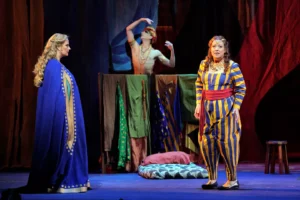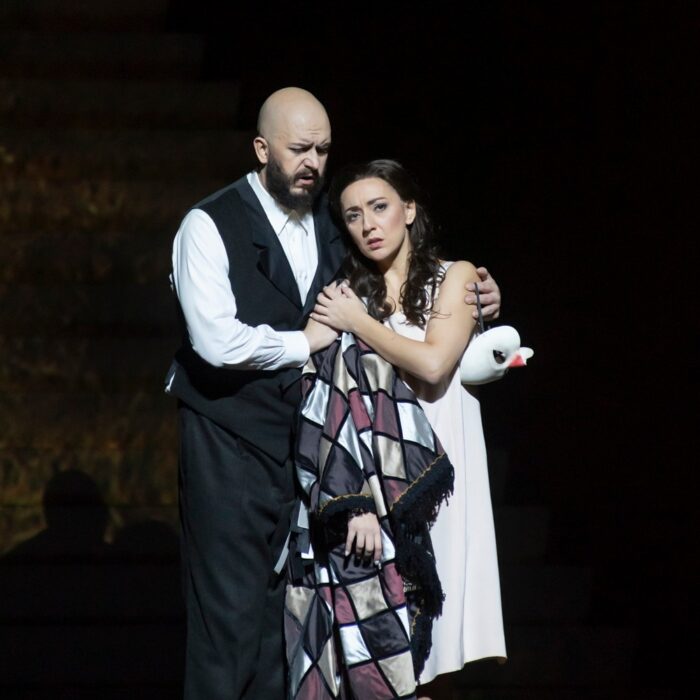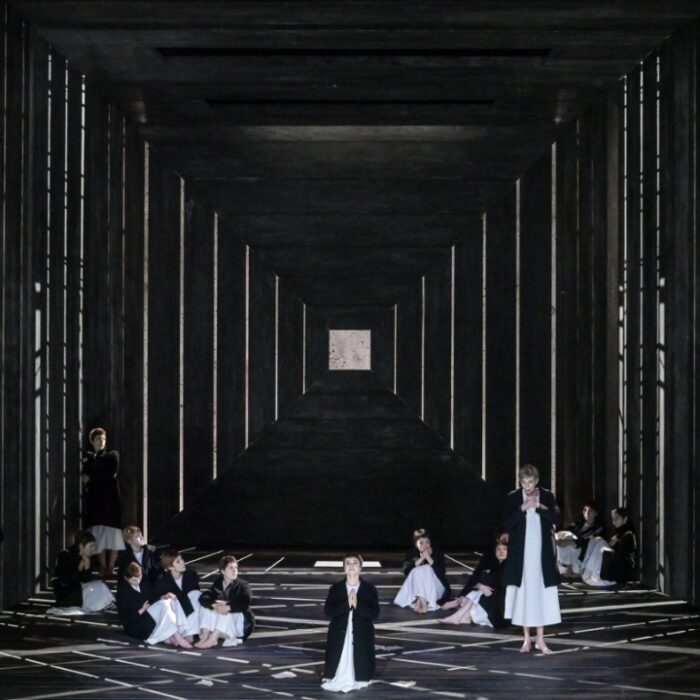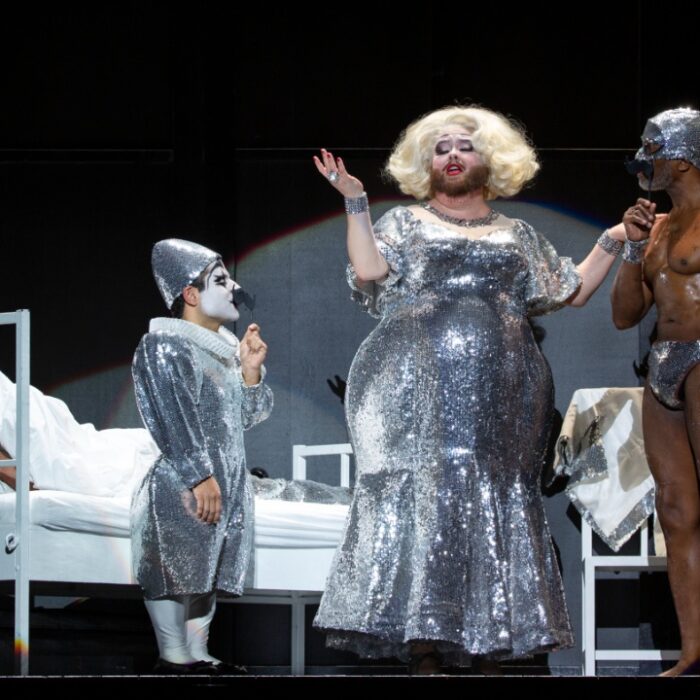
San Francisco Opera 2022-23 Review: Die Frau ohne Schatten
R. Strauss’ Rarely Staged Work is a Glorious Soul-Stirring Spectacle in San Francisco.
By Lois SilversteinCredit: San Francisco Opera
On June 4, a Sunday afternoon, everyone was high with anticipation. David Hockney‘s production of R. Strauss’ “Die Frau ohne Schatten” was opening at San Francisco Opera. Since its American premiere in 1959, the work had only been rarely mounted in San Francisco (five times since 1959), or in other houses, in Paris or Vienna, or Milan, if at all. How could that be? The show features 96 Instrumentalists in the pit, 110 performers on and around the stage, a score that calls for two out-of-the-hall sopranos, and a story that matches only “Die Zauberflöte” and Wagner’s “Ring” for its out-of-the-ordinary-world concerns. Even the best, the mightiest, the most affluent of houses can’t easily pull together such a production.
And yet, here was San Francisco Opera, during its 100-year anniversary, showing it with a cast of glittering, highly accomplished, and remarkable singers. At two p.m., the curtain rose with Sir Donald Runnicles, renowned Strauss conductor, at the helm. On stage was opera royalty: Swedish soprano Nina Stemme; Finnish soprano Camilla Nylund; and American soprano Linda Watson in her long overdue company debut. It was a wonder to behold. Male singers included Danish bass-baritone Johan Reuter, British tenor David Butt-Philip and bass Stefan Egerstrom, among others.
A Sonic & Visual Feast Unfolds in the Pit and Onstage
The star of the production was the score, and Runnicles’ conducting brought a vision of what heaven might be like with color, texture, and sounds that reached beyond the usual planetary sphere that soaked the stars. And this, alongside sets and costumes, even Marc Chagall’s palette couldn’t easily match.
From Runnicles’ downbeat until the end, it was as thrilling as a high-wire act. Who could easily predict where Strauss’s sounds would take the audience? The very range of the instrumentation was formidable: six trumpets, four trombones, nine horns, one tuba, one timpani, four other percussion instruments, two harps, two celestes, one glass harmonica, and fifty strings. Four flutes, three oboes, five clarinets, and four bassoons joined these. Throughout the work, the audience heard new and unusual combinations from the pit and offstage, with adult and children’s choruses and various combinations of singers amplified backstage. It was a sonic feast Strauss had worked on for years.
The text by Hugo von Hofmannsthal should be acknowledged for its complexity and fantastical elements. At its core is the story of one woman, the Empress, trying to buy the shadow of a human, the Dyer’s Wife, so she can sidestep the Emperor turning to stone, the consequence that awaited if she didn’t bear children. As critics have written, the requisite view that women’s primary function is to have children, buying and selling shadows for that purpose is hardly popular. Still, the story is as Hofmannsthal created it, and as it plays out on stage, our era challenges the audience.
With all the color, movement, and sound coming from the pit, backstage, stage center, right and left, from rotating platforms and overhead projections, we can give it a tip of the hat while not galvanizing opposition regarding its operatic value. Even when compared to Wagner’s “Ring” theses, it’s unnecessary to resolve for audiences to enjoy the show. Shadows lost and given, cut off and rehung, don’t drag us away from the stuff of spectacle. Members of the audience may have questioned, “Where are we?” This reviewer’s neighbor in the seats leaned over to ask just that, also asking, “What is happening and why?” The only way to enjoy the experience properly was to descend into it, to submit and enjoy. That was easy to do.
SFO pitched the production high enough for the audience to savor, especially in its commingling of human and superhuman conflicts set in glamorous technicolor. In “Die Zauberflöte,” we let ourselves fly off the ground with the story, and a detailed understanding of its mysteries never stopped us from lifting off through the music itself. Neither do we flounder with the mysterious shadow story Strauss presents here, either. However much the foggy and extreme esotericism of the work pervaded, it was the music itself that captivated the heart and the head. The audience needn’t stumble on the river banks of doubt or confusion, even in a parade of eleven scenes in three full acts. Strauss whimsically called the opera his ‘frosch,’ or ‘frog,’ using the initial letters of its title. Though playful, the work transcends.
Captivating Performances and Resounding Voices
The sounds made by the Dyer’s Wife (Nina Stemme), the Empress (Camilla Nylund), and Nurse (Linda Watson) clung to the audience with their contest of power, their arcs, and boom-value throughout the performance. The audience went from one race to the top to another. Rarely has the opera house resounded with such a collection of sounds. The three sopranos dazzled and reached the realms where gold lay.
The men’s voices fell shorter than that of the women, although Johan Reuter’s bass-baritone stayed sonorous throughout and provided a well-needed counter to the high reaches traveled by the women’s voices. Its timbre and poignancy worked well, as did the contrast of colors. The Emperor, sung by tenor David Butt-Philip, was sharper and thinner, and while ample enough, it did not carry quite enough weight. But the cast of fine singers contributed more sound than even San Francisco is used to hearing.
To speak about the color on stage as only sensory input would be limiting. The various stage effects, plus stripes and solids, oranges, pinks, and magentas, were more than dazzling. As were Hockney’s shapes. Under the hand of stage director Roy Rallo and costume designer Ian Falconer, the shapes—dots, dashes, and fields of abstractions easily impressed. From the first downbeat to the remarkable finale, with its four lovers, earthly and heavenly, singing away in glorious affirmation, the production held the audience in awe.
Nina Stemme in a striped jumpsuit—sporting a new one with each scene—coordinated with the striped scenery featuring red, turquoise, green, blue, yellow, and mustard, showing the connection between time and space. It reckoned with our own wish to suspend all disbelief as we traveled through the three-day timeline in three hours and 47 minutes of real-time, during which the Empress needed to grab a shadow and save the Emperor from turning into stone. The riot of activity, people, sound, and extravagance brought the house down, whether it was everybody’s cup of tea or not. The lighting by Alan Burrett, the original design, and its revival design by Justin A. Partier, added another explosive dimension. Choir director John Keene stirred the chorus to new heights, while choreographer Colm Seery staged the dancers and Dave Maier orchestrated the fight scenes.
It was a gala, an extravaganza, a spectacle. A “gesamtkunstwerk” for sure, and although Strauss and Hofmannsthal’s elaborate carnival couldn’t match Wagner’s intellectual purposes, no one could say they didn’t amp up their spectacle the best they could.
The final round of bows included Nina Stemme being awarded the San Francisco Opera Medal from the company. When placing the medal around Stemme’s neck, San Francisco Opera Director Matthew Shilvock acknowledged she had joined previous winners Sir Donald Runnicles, Birgit Nilsson and Leonie Rysanek, and others in receiving the high honor. It was another memorable moment in the afternoon’s many feasts.


